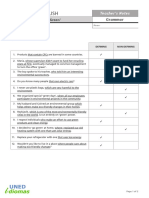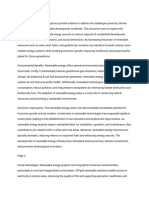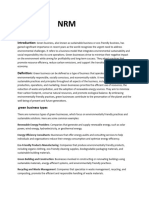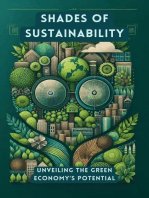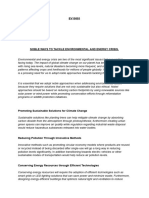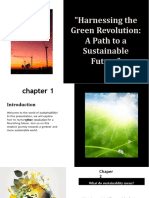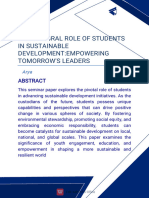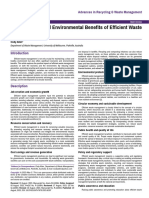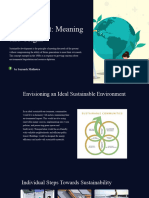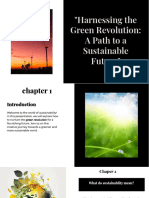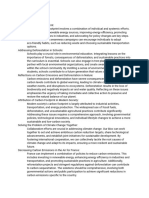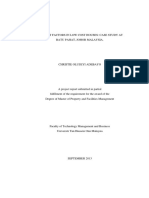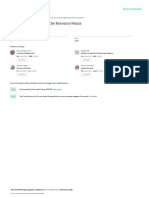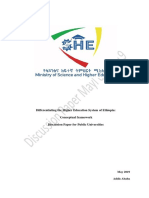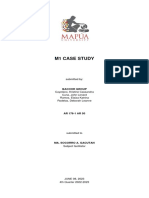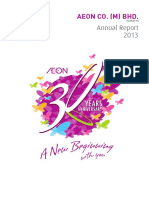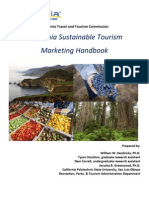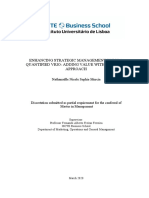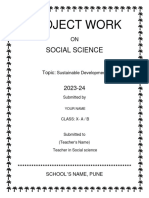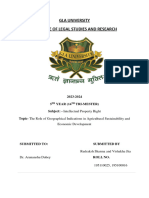Professional Documents
Culture Documents
Loganathan Ail Thinagara Raj
Loganathan Ail Thinagara Raj
Uploaded by
loga73611Original Title
Copyright
Available Formats
Share this document
Did you find this document useful?
Is this content inappropriate?
Report this DocumentCopyright:
Available Formats
Loganathan Ail Thinagara Raj
Loganathan Ail Thinagara Raj
Uploaded by
loga73611Copyright:
Available Formats
LOGANATHAN AIL THINAGARA RAJ
090425-06-0767
SMK Gambang /CEA4095
Journey to a Greener Future
In today's rapidly evolving world, the need to address environmental challenges
and transition to a greener future has become increasingly urgent. This essay
examines the steps needed to achieve a greener future, including the
implementation of sustainable practices, prioritization of renewable energy sources,
and promotion of environmental awareness.
One of the key steps towards a greener future is the widespread adoption of
sustainable practices. This includes reducing waste generation, promoting recycling
and composting, and minimizing the use of non-renewable resources. For instance,
individuals can reduce waste by practicing mindful consumption, opting for reusable
items, and embracing the concept of reduce, reuse, and recycle. Moreover,
businesses and industries can adopt sustainable manufacturing processes by
incorporating circular economy principles, such as product lifecycle assessment and
eco-design. By minimizing waste and maximizing resource efficiency, sustainable
practices not only contribute to a greener future but also help in conserving natural
resources.
Another crucial aspect of the journey towards a greener future is the
prioritization of renewable energy sources. Transitioning from fossil fuels to cleaner
sources of energy, such as solar, wind, and hydroelectric power, is essential to
mitigate the impacts of climate change. Governments and policymakers play a
significant role in incentivizing the adoption of renewable energy through subsidies
and regulatory frameworks. Additionally, investment in research and development is
crucial to enhance the efficiency and affordability of renewable energy technologies.
By investing in renewable energy sources, we can reduce greenhouse gas
emissions, improve air quality, and create a sustainable and secure energy future.
To ensure a successful transition to a greener future, promoting environmental
awareness is paramount. Education and awareness campaigns can help individuals
and communities understand the importance of sustainable practices and encourage
them to take action. Schools and educational institutions can integrate environmental
education into their curricula, raising awareness among the younger generation.
Furthermore, public awareness campaigns can be conducted to highlight the
benefits of renewable energy and the negative impacts of unsustainable practices.
By fostering environmental awareness, we can foster a culture that values
sustainability and embraces the necessary changes for a greener future.
To achieve a greener future, the implementation of sustainable practices is
crucial. One example of this is the adoption of recycling programs in cities and
communities. By providing recycling bins and educating residents about the
importance of recycling, significant amounts of waste can be diverted from landfills.
Another example is the promotion of sustainable agriculture practices. By using
organic farming methods and reducing the reliance on chemical pesticides and
fertilizers, we can protect soil health, preserve biodiversity, and minimize water
pollution. Additionally, businesses can contribute to sustainability efforts by
implementing energy-efficient measures such as using LED lighting, installing solar
panels, and embracing green building practices. These are just a few examples of
the many sustainable practices that can be implemented to move towards a greener
future.
Transitioning to a greener future requires a collective effort from individuals,
businesses, governments, and communities. By implementing sustainable practices,
prioritizing renewable energy sources, and promoting environmental awareness, we
can create a more sustainable and resilient future. It is crucial for all stakeholders to
actively participate in and support the journey to a greener future for the well-being of
our planet and future generations.
(988 words)
You might also like
- A4 M5 Teacher GrammarDocument2 pagesA4 M5 Teacher GrammardopazomanNo ratings yet
- Towards A Greener Future Environmental AdvancementsDocument1 pageTowards A Greener Future Environmental AdvancementsJaNo ratings yet
- GE AssignmentDocument3 pagesGE AssignmentCharu GautamNo ratings yet
- Debate TopicDocument2 pagesDebate Topicmanishpatnaik524No ratings yet
- 1Document2 pages1Alexandra NielNo ratings yet
- New Microsoft Word DocumentDocument2 pagesNew Microsoft Word DocumentSaqib MushtaqNo ratings yet
- Green RootsDocument10 pagesGreen RootsMahad IlyasNo ratings yet
- The Rise of Sustainable LivingDocument2 pagesThe Rise of Sustainable LivingMejoTewNo ratings yet
- Evs AssignmentDocument1 pageEvs Assignmentvirajsurana123No ratings yet
- The Necessity of Implementing Sustainable Practices in Daily LifeDocument3 pagesThe Necessity of Implementing Sustainable Practices in Daily LifeAlkhaizar Abdullah100% (1)
- NRM NotesDocument29 pagesNRM NotesManisha PantNo ratings yet
- Plastic Waste and e Waste RecylingDocument14 pagesPlastic Waste and e Waste Recylingoffice.adminNo ratings yet
- Escueta Ritchel Ais221 Ass 1Document1 pageEscueta Ritchel Ais221 Ass 1Chel EscuetaNo ratings yet
- Title: Doing Better For Mother Earth: A Call To Environmental ActionDocument3 pagesTitle: Doing Better For Mother Earth: A Call To Environmental ActionSudhanwa KulkarniNo ratings yet
- Shades of Sustainability: Unveiling the Green Economy's PotentialFrom EverandShades of Sustainability: Unveiling the Green Economy's PotentialNo ratings yet
- Eco-Strategies To Improve Quality of LifeDocument1 pageEco-Strategies To Improve Quality of LifeBojana PetreskaNo ratings yet
- EV10003 Ass2Document2 pagesEV10003 Ass2mohitmajhi2004No ratings yet
- Essay 2Document1 pageEssay 2movieexclusive02No ratings yet
- Waste SolutionsDocument3 pagesWaste SolutionsVeerendra Kumar ManemNo ratings yet
- Writing Task 1 2 IeltsDocument3 pagesWriting Task 1 2 IeltsAlamin TalukderNo ratings yet
- TCS EssayDocument4 pagesTCS Essayswin0897.eduNo ratings yet
- Wepik Implementing Effective Strategies For Addressing Climate Change 202402291618576owrDocument15 pagesWepik Implementing Effective Strategies For Addressing Climate Change 202402291618576owrelnur020420No ratings yet
- A Decade of Positive ImpactDocument1 pageA Decade of Positive ImpactSamer MamdouhNo ratings yet
- Essay 1 - SustainabilityDocument1 pageEssay 1 - SustainabilityKenneth The GreatNo ratings yet
- Wepik Seeding Sustainability Nurturing The Green Revolution For A Flourishing FutureDocument17 pagesWepik Seeding Sustainability Nurturing The Green Revolution For A Flourishing FutureayushpathakjaplaNo ratings yet
- A Holistic Approach To Tackling The Climate CrisisDocument2 pagesA Holistic Approach To Tackling The Climate Crisism-10325855No ratings yet
- Sustainable FutureDocument3 pagesSustainable FutureJasonNo ratings yet
- The Importance of Sustainable LivingDocument1 pageThe Importance of Sustainable Livingjenalyn1206No ratings yet
- New Text DocumentDocument1 pageNew Text DocumentphungvuquanganhNo ratings yet
- Essay 1Document2 pagesEssay 1diveshmistry73No ratings yet
- Sustainibility ConceptDocument1 pageSustainibility ConceptnikNo ratings yet
- Title - Environmental Sustainability - Nurturing Our Planet For Future GenerationsDocument2 pagesTitle - Environmental Sustainability - Nurturing Our Planet For Future GenerationssharonNo ratings yet
- International Seminar-3Document8 pagesInternational Seminar-3SwedhaNo ratings yet
- International SeminarDocument8 pagesInternational SeminarSwedhaNo ratings yet
- S3Document1 pageS3Chrono KeeperNo ratings yet
- B Ing DedeDocument2 pagesB Ing Dedeagus pratamaNo ratings yet
- Firms Implementing Sustainibility AnirudhDocument16 pagesFirms Implementing Sustainibility AnirudhVaishnavi ShetNo ratings yet
- The Economic and Environmental Benefits of Efficient Waste ManagementDocument2 pagesThe Economic and Environmental Benefits of Efficient Waste ManagementDRECONo ratings yet
- How To Manage Garbage To Protect The EnvironmentDocument3 pagesHow To Manage Garbage To Protect The EnvironmentpushpakgorankarNo ratings yet
- 4C ArticlesDocument8 pages4C ArticlesVaisshanaviNo ratings yet
- Climate Change Mitigation Strategies - Navigating Towards A Sustainable FutureDocument2 pagesClimate Change Mitigation Strategies - Navigating Towards A Sustainable FutureChantriaNo ratings yet
- Balancing Energy Needs and Environmental SustainabilityDocument2 pagesBalancing Energy Needs and Environmental Sustainabilityashlynkumar2007No ratings yet
- Green EconomyDocument7 pagesGreen Economyvivek0724bryantNo ratings yet
- Small Difference Big ChangeDocument1 pageSmall Difference Big ChangeKwabena Ampong Baidoo Jnr.No ratings yet
- SustainabilityDocument2 pagesSustainabilitychantrea RiegoNo ratings yet
- SdsDocument1 pageSdsDeftu Andrei RazvanNo ratings yet
- Research Work On Ecological CompaniesDocument4 pagesResearch Work On Ecological Companiesapi-692456531No ratings yet
- GLW Discussion Forum - Team 2-9-11Document11 pagesGLW Discussion Forum - Team 2-9-1101- 2G TMPP -Abraham Thiong Ajak ThiongNo ratings yet
- Green Technology DiscussionDocument4 pagesGreen Technology DiscussionAinin SofeaNo ratings yet
- Sustainable Development Meaning and OriginDocument11 pagesSustainable Development Meaning and OriginSayanshNo ratings yet
- The Escalating Threat of Climate Change Has SpurreDocument1 pageThe Escalating Threat of Climate Change Has SpurreNicholas BadeaNo ratings yet
- Raushan PathakDocument17 pagesRaushan PathakayushpathakjaplaNo ratings yet
- Untitled Document 2Document2 pagesUntitled Document 2tianna.m.parmarNo ratings yet
- PriyankaDocument10 pagesPriyankaDeepak Kumar AryaNo ratings yet
- Climate ChangeDocument2 pagesClimate ChangeLarva MusicaNo ratings yet
- Factors Affecting Improper Waste Disposal in Nabua NHSDocument27 pagesFactors Affecting Improper Waste Disposal in Nabua NHSMichael Vince Allyn AlbaoNo ratings yet
- Wepik Adapting To The Anthropogenic Impact Addressing Climate Change 20240304073012HDgjDocument12 pagesWepik Adapting To The Anthropogenic Impact Addressing Climate Change 20240304073012HDgjsachdevarudra71No ratings yet
- Green Transformation & SustaninabilityDocument18 pagesGreen Transformation & Sustaninabilityshweta JainNo ratings yet
- Mitigating Climate Change, Innovative Solutions For A Sustainable Future in 2024Document2 pagesMitigating Climate Change, Innovative Solutions For A Sustainable Future in 2024Channa SamarasingheNo ratings yet
- UntitledDocument1 pageUntitledSuparna Prageet SarkarNo ratings yet
- Urban Farming SummaryDocument4 pagesUrban Farming SummaryhgordonsmithNo ratings yet
- Important Days and Themes 2022Document10 pagesImportant Days and Themes 2022RamswaroopNo ratings yet
- Housing ComfortDocument63 pagesHousing ComfortaqilahNo ratings yet
- Routledge Handbook of The Resource Nexus: January 2018Document3 pagesRoutledge Handbook of The Resource Nexus: January 2018cntudoseNo ratings yet
- 2023 IPA Annual ReportDocument90 pages2023 IPA Annual ReportDaniel PandapotanNo ratings yet
- Discussion PaperDocument42 pagesDiscussion Paperasnescrib100% (5)
- Establishment of A Reserve List For Junior Professional ProfilesDocument8 pagesEstablishment of A Reserve List For Junior Professional ProfilesAlexNo ratings yet
- Impact of Green HRM Practices On OrganizationsDocument1 pageImpact of Green HRM Practices On OrganizationsCatherine ElvisNo ratings yet
- Water InfrastructureDocument38 pagesWater InfrastructureMayank SenNo ratings yet
- Literature Review On Water Treatment PlantDocument8 pagesLiterature Review On Water Treatment Plantea5vpya3100% (1)
- Bacoor-Group Ar176-1 A50Document16 pagesBacoor-Group Ar176-1 A50John Lenard CunaNo ratings yet
- 2021 Sustainability FinalDocument36 pages2021 Sustainability FinalLovely ChoudharyNo ratings yet
- Education Planning and Administration: Dr. Radhika KapurDocument20 pagesEducation Planning and Administration: Dr. Radhika Kapursimba 2020100% (1)
- Gandhi and EnvironmentDocument34 pagesGandhi and EnvironmentRiya100% (2)
- AEON Annual Report 2013Document124 pagesAEON Annual Report 2013irwan suhadi bin saharNo ratings yet
- California Sustainable Tourism Marketing HandbookDocument29 pagesCalifornia Sustainable Tourism Marketing HandbookPresa Rodrigo Gómez, "La Boca"No ratings yet
- Space Mining Paper 2020Document10 pagesSpace Mining Paper 2020Andrés GilNo ratings yet
- Part 01 Joint Business Practice Request For TenderDocument73 pagesPart 01 Joint Business Practice Request For Tenderfabiano_projetoNo ratings yet
- Master Nathanaelle Sophie MurciaDocument93 pagesMaster Nathanaelle Sophie MurciaHisham HeedaNo ratings yet
- The Role of Financial Management in Promoting Sustainable Business Practices and DevelopmentDocument22 pagesThe Role of Financial Management in Promoting Sustainable Business Practices and DevelopmentJosh GonzalesNo ratings yet
- A Metropolis For People - Jan Gehl PDFDocument16 pagesA Metropolis For People - Jan Gehl PDFAngel VeraNo ratings yet
- Technology Management Assignment 1Document5 pagesTechnology Management Assignment 1Abhiroop SenNo ratings yet
- Ashol Lall: Beacon of Sustainable Architecture: IRRAD Gurgaon by Ashok B Lall ArchitectsDocument2 pagesAshol Lall: Beacon of Sustainable Architecture: IRRAD Gurgaon by Ashok B Lall ArchitectsMonisha100% (1)
- Greenery, Buildings and Feng ShuiDocument10 pagesGreenery, Buildings and Feng ShuideNo ratings yet
- History & Geography CHPT 3 MexicoDocument13 pagesHistory & Geography CHPT 3 MexicoJeremae Rauza TenaNo ratings yet
- TLISK - CL-X - Sample Project Format - SST - PDFDocument10 pagesTLISK - CL-X - Sample Project Format - SST - PDFRishit BaranwalNo ratings yet
- The Role of Geographical Indications in Agricultural Sustainability and Economic DevelopmentDocument8 pagesThe Role of Geographical Indications in Agricultural Sustainability and Economic DevelopmentRudraksh SharmaNo ratings yet
- Eurocodes: Background & Applications Structural Fire Design: Worked ExamplesDocument256 pagesEurocodes: Background & Applications Structural Fire Design: Worked ExamplesSantanu GhoshNo ratings yet
- Sustainable Design PrinciplesDocument15 pagesSustainable Design PrinciplesyaraNo ratings yet
